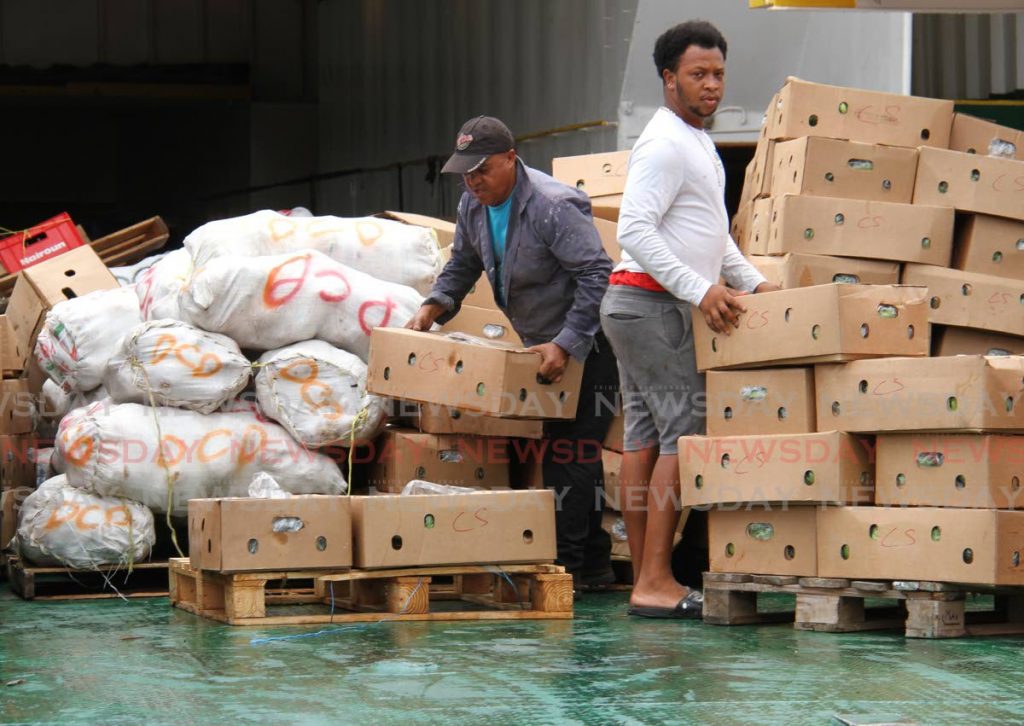St Vincent exports produce despite La Soufriere

Despite the devastation to the St Vincent and the Grenadines (SVG) agricultural industry caused by the eruption of the La Soufriere volcano – the most devastating impact in the agricultural sector has faced in more than 100 years – tonnes of produce grown by SVG farmers still arrived on Trinidad and Tobago's shores on Tuesday.
The produce came to TT’s ports on the Admiral Bay 1, one of three ships transporting the majority of produce from SVG to TT.
The haul included root crops – dasheen, eddoes and ginger – and above-ground crops including soursop, green fig, mangoes and coconuts.
“It was a surprise to me to see that even after what took place in SVG, that goods still came. They are still feeding people in TT,” said Clifford “Lau” Jones, a loader at the docks.
While dock workers and traders expressed happiness over the delivery of produce, several still worry that in the coming months there may still be a shortage of goods from SVG as it continues to deal with the effects of the erupting volcano.
“I won’t say things are 100 per cent grim, but things will be hard. I think it would be a year and a half to two years before things normalise,” said Cornelius “Senator” Stowe, one of the deckhands on the Admiral Bay 1. “We have to think about cleaning up and growing after and so on. And rainy season is in the next few weeks.”
While the entire country was covered in volcanic ash as a result of the eruption, different crops were affected differently because of the areas where they are produced.
Because of the volcano, SVG was separated into four zones – the red zone, closest to the volcano; orange zone, which is further away; the yellow zone, which is even further; and the green zone, the furthest from the volcano. Minister of Agriculture Saboto Caesar told Newsday the red zone, where the danger is at its highest, is usually used for illicit cannabis, coconuts, arrowroot, and cocoa. The root crops are normally produced in the yellow zone, which was less affected because of its distance from La Soufirere.
In addressing questions of food security and a possible rise in prices for root crops in light of the limited supply, Caesar said exports of above-ground crops like plantains and bananas may slow to a trickle, but root crops would not be affected
“Is not one dasheen the man a plant, inno, is mountain size of dasheen,” Caesar said jovially while talking to Newsday. “Because we don’t have factories in SVG that can process large quantities of our root crops we export.”
He explained that after SVG takes the amount of crops needed to feed its population of 110,000 it exports the rest. SVG, Jamaica and Dominica are the main exporters of root crops in the region.
“We have close to a century of ongoing trade between SVG and TT,” Soboto said. “We have a network of close to 500 people who focus on supplying produce to TT – people with established contractual initiatives. They would do everything legal to satisfy TT demands.”
Caesar added that SVG would ensure that it works with TT to give real-time information on the quantities of produce, so preparations could be made locally.TT Minister of Agriculture Clarence Rambharat said if there was any shortfall, local production has the capability to pick up the slack.
And if all else fails, Caesar said, the Dominican Government promised to supply Vincentian traders to offset any shortages of root crops that may occur.
But the focus for SVG is recovery and taking care of its displaced citizens
“We had over 15,000 people dislocated from their homes. That has to be addressed first, because people are first important.”
Afterwards the SVG government would have to take advice from scientists on a fresh look at how the available land is assessed.
“There is still a question mark as to when the red zone would be safe again and what commodities would be produced there. Will we use livestock? Because we can move that.”
Caesar added that there may be a shift in how some commodities are prioritised. He noted, however, that since government is not directly involved in food production and only provides an enabling environment for the industry, the final word on what is prioritised would come from the private sector.
Caesar said while there would be difficulty, he is confident that SVG has the resilience to recover.
“Ministers are optimistic on the recovery that would take place in the short to medium term, and I welcome the solidarity from other ministers of agriculture,” he said.


Comments
"St Vincent exports produce despite La Soufriere"